Abstract
Mongolian women enjoy equal rights and actively participate in various sectors of the national economy, including the mineral and mining industry. The Mongolian University of Science and Technology (MUST), the largest university in Mongolia, plays a crucial role in preparing engineers for the Mongolian industry. Within MUST, the School of Geology and Mining Engineering (SGME) stands out as one of the largest schools, boasting a dedicated team of 136 staff members. Impressively, 92 of these staff members are female, constituting a remarkable 67.65% of the total staff. The directorial board of SGME, consisting of 12 members, also demonstrates a noteworthy level of gender diversity, with 5 of its members being female. This represents a proportion of 41.67% and highlights the inclusion of women in decision-making positions. Additionally, it is worth noting that the Geology and Hydrogeology department, one of the five departments within the School, is led by a capable female leader. However, despite the encouraging representation of women among staff and in leadership roles, there is a noticeable disparity in the enrollment and graduation rates of students at SGME. Currently, these rates stand at only about 20–24 percent, indicating the need for further efforts to encourage and support female students in pursuing geology and mining engineering studies. Outside of academia, within the mining industry, the Oyu Tolgoi large-scale mine, which in 2022 employed 20,328 workers, faces a significant gender imbalance. Out of this workforce, only 3577 are women, comprising a mere 18% of the total employees, while the remaining 82% are men. Among the 2997 total employees in the open pit mine, 737 women are employed in various roles, including 66 engineers and technicians, with the remaining 671 in other positions. In the newly opened underground mine, the total number of women employees stands at 2840, including 248 engineers and technicians and 2592 in other roles. Furthermore, on the Board of Directors, there are only 2 women out of a total of 23 managers, and a mere 104 women hold positions as senior staff and superintendents. A comparative analysis between Asia and other global regions reveals that female employment in Mongolia’s mining sector in general, at 18%, closely aligns with Oceania’s rates (17%) and surpasses those of both the broader Asian region (13%) and South America (11%). Addressing these statistical imbalances is crucial to improving gender equality in geoscience and mining. Historically, the mining industry has been male-dominated, but women-led professional geoscience and mining organizations in Mongolia play a vital role in promoting the recruitment, retention, and advancement of women in these industries. Recognizing the significance of gender diversity, these organizations strive to increase the representation of women in leadership positions. Women in leadership bring unique perspectives that contribute to well-rounded decision-making processes within organizations. By acknowledging the importance of gender dynamics, promoting inclusivity, and supporting the professional growth of Mongolian women in geoscience and mining, the overall development and sustainability of these sectors in the country will be greatly enhanced.
1. Introduction
Modern women in Mongolia have equal rights and work in various sectors of the national economy. Historically, Mongolian women played an economic role in nomadic society and had power and freedom in comparison with other Asian countries. The socialist period (1921–1992) opened the door for women’s education and social welfare. Socialist government policy guaranteed equality in education, the workplace, and the political system. The success of the governmental policy contributed to the high percentage of educated women, e.g., more than a quarter of university and college graduates were women. Transferring to a market economy in 1992 brought more freedom and choice, leading to negative phenomena like unemployment and the gender equality index (GEI) decreasing (e.g., the latter to 0.71); however, these metrics remained higher than in neighboring counties. Now, Mongolia is ranked as a country with high gender development. Mongolia’s 81 points rank her among countries with medium GEI, twelve points above the average across East Asia and the Pacific. In 2022, the global gender gap index for Mongolia was 0.72.
Gender equality is a fundamental human right, and the advancement of gender equality is one of the critical development and policy objectives for Mongolia. In 2011, the State Great Hural (parliament) adopted the Law on Promotion of Gender Equality. This law specifically ensures gender equality in political, legal, economic, social, cultural and family relations and regulates relations related to their implementation.
While Mongolia has made steady progress towards improving gender equality in the past, there are still a number of challenges and barriers for women to have equal representation and participation in social, professional, and political spheres. As of 2020, 17.1% of Mongolia’s Parliament, the highest legislative body, are female, which is well below the global average of 24.9%. Furthermore, only 27.1 percent of the local Citizen’s Representative State Great Hural members are female. Though Mongolia ranked as a country with high gender development, the country’s gender inequality index is below the regional and global average according to UNDP’s 2020 Human Development Report.
Many international projects have been implemented in Mongolia recently. For example, the Korea International Cooperation Agency (KOICA) and United Nations Development Program in Mongolia (UNDP) initiated the “Promoting Gender Equality in Decision-Making and Women’s Empowerment in Mongolia” project; the Asia Foundation launched the four-year “Women’s Economic Empowerment Project in Mongolia”, which is funded by Global Affairs Canada, and the U.S. government announced their “Strengthening Women and Youth Engagement in the Electoral and Political Processes in Mongolia” project that will “elevate the role of women in society and the political process”. All of these initiatives address the improvement of the social position of women. The rapid growth of mining in Mongolia has the potential to have a significant positive impact on the lives of women and other vulnerable groups. Indeed, evidence suggests that some women have benefitted from increased employment and business opportunities associated with mining [1].
Today, women work in all spheres of society, including the Geoscience and Mining branches. They lead and participate in international and domestic research projects, international symposiums, and congresses, are members of Mongolian and international professional organizations, publish books and papers in international peer-reviewed journals, and many are graduate students (master’s and PhD) in geoscience and mining engineering [2,3].
The position of Mongolia within the Central Asian Orogenic Belt, assembled by subduction–accretion, is favorable for world-class mineral deposits. The main types of economic metallic mineral deposits were formed during the Neoproterozoic through to the Phanerozoic. Mongolia has high concentrations of deposits and prospects of copper, base metals, gold, coal and uranium [4]. The mining sector, a significant contributor to the economic development of Mongolia, accounts for 24% of the country’s GDP and 72% of the gross industrial output. Proven reserves include 69.9 Mt of copper, 33.4 Bt of coal, 34.2 Mt of fluorspar, and iron ore of 1.84 Bt. Mongolia produces and exports copper concentrate, coal, iron, fluorspar, gold, silver, uranium, and zinc. Mongolia’s total export of mineral products reached 70% in 2022, with the export of coal running at 98.9%, copper concentrate at 87.7%, iron ore at 59.8%, gold at 68.8%, and zinc at 103.8 percent, as reported by the Ministry of Mining and Heavy Industry in September 2022.
Mongolia is a mining country, but a preliminary analysis of ILO mining employment data by sex in 2020 suggests the role of women in the mining sector is relatively low. In 2020, the Mongolian national workforce consisted of 53% male and 47% female employees of the working age population (of 46% male and 54% female). Mining and quarrying activities accounted for 4% of occupations in Mongolia in 2020, and the ILO estimates that the participation rate for female workers in the mining category was only 16%. Female employees participate in most occupation roles in mining but in very low numbers. For example, female mining professionals represent only 2% of the total mining workforce compared with male professionals who make up 14%. Female plant and machine operators and assemblers comprise only 2% of the total mining workforce, compared with males, who make up 45%. The statistics are slightly closer in the ‘Craft and Related Trades Workers’ category, where women make up 1% of the total mining workforce and males 8%. At management level, 2% the total workforce is female, while 3% is represented by male managers. On the other hand, female employees have a higher proportion of advanced-level education (47%) in mining compared to their male counterparts (37%). The proportion of male workers is well above the national working age population in the age range of 25–54 years. Female workers are underrepresented in every age range. Female mining employees reported that they worked an average of 6.3 fewer hours than males, in their paid roles in 2020 [5].
In this paper, we highlight the role of women in geoscience and mining, using the Mongolian University of Science and Technology and the Oyu Tolgoi mine as examples.
2. Women at the Mongolian University of Science and Technology
The Mongolian University of Science and Technology (MUST) is indeed one of Mongolia’s largest state universities. It was established in 1959 and has a long-standing reputation as a leading educational institution in the country. As one of the largest state universities, MUST offers a wide range of academic programs and disciplines to cater to the diverse educational needs of students. The university is dedicated to providing quality education and promoting research and innovation in various fields, including science, technology, engineering, and more.
Over the years, MUST has witnessed significant growth in terms of enrollment and academic staff. As of the latest available statistics, the university boasts an impressive enrollment of 12,333 students who are supported by a dedicated staff of 1570 individuals (https://www.must.edu.mn/mn/ in Mongolian; accessed on 27 June 2023). These numbers reflect the university’s commitment to providing educational opportunities and fostering an environment conducive to learning and research. With its establishment over six decades ago, MUST has played a significant role in nurturing scholars and faculty members, contributing to the development of Mongolia’s academic landscape. Through its academic programs, research endeavors, and contributions to the development of Mongolia’s workforce, the Mongolian University of Science and Technology continues to play a crucial role in shaping the country’s educational landscape and preparing students for the challenges of the modern world.
The educational reform implemented by the Mongolian University of Science and Technology in the 1990s was a significant step towards improving the quality and effectiveness of its education system. This reform was a response to the changing economic and social conditions in Mongolia, as well as the need to adapt to advancements in technology and the increasing influence of globalization. The educational reform initiatives focused on measuring educational outcomes, curriculum reform, decentralization of the educational system, and increased emphasis on teacher training.
In the field of geology and mining, MUST implemented projects funded by international organizations to further enhance the education and training provided in these areas. Projects such as TASIS-TEMPUS, funded by the European Union, focused on teacher training and curriculum development in Geology and Mining. These projects aimed to improve the expertise of teachers and enhance the curriculum to meet industry requirements. Additionally, the Canadian International Development Agency (CIDA) funded the “Education for Environmental Transition: Mining in Mongolia” project from 2004 to 2010. This project aimed to strengthen MUST’s capacity for training future geologists, government officials, and professionals involved in the mining industry. The focus was on equipping them with the necessary skills to implement environmentally sustainable mining practices. As part of these initiatives, gender studies in geoscience were conducted to understand and address gender-related issues in the field [6].
Overall, the educational reform undertaken by MUST aimed to align its education system with the changing needs of society and industry. Through various projects and initiatives, MUST sought to enhance the quality of education, promote sustainability in mining practices, and address gender disparities in the geoscience field.
MUST welcomes a significant influx of new students each academic year, with a wide range of options available across its 14 schools encompassing 286 professional programs. To illustrate, in the 2021–2022 academic year alone, MUST admitted 3869 bachelor’s degree students, 553 master’s degree students, and 85 doctoral students. Additionally, during the same period, the university celebrated the graduation of 2616 bachelor’s degree recipients, 612 master’s degree recipients, and 40 doctoral graduates. Moreover, it is noteworthy that female students comprise a meaningful portion of the university’s student body, constituting 34.57% of the total student population at MUST. This diversity and inclusivity further enhance the academic environment and contribute to a vibrant campus community.
Gender ratio data are also available for different positions within the university’s human resources. Out of the staff members, 1014 are female, making up 66.14% of the workforce. The directorial board of MUST consists of 23 members, with four of them being female (17.4%). All 15 members of the representative board are male, while 49% of the department heads are female [7]. Overall, the gender ratio for leadership positions at MUST stands at 66.7% male and 33.3% female.
The MUST offers bachelor’s, master’s, and PhD programs in various fields such as Applied Geology, Exploration of Mineral Resources, Hydrogeology, Engineering Geology, Environmental Geology, Geodesy, Mining Engineering, Mineral Processing, Mining Machinery, and Mining Economics. The School of Geology and Mining Engineering (SGME) is one of the largest schools within MUST, comprising a total of 136 staff members. Out of the SGME staff, 92 are female, accounting for 67.65% of the staff. The directorial board of SGME consists of 12 members, with 5 of them (41.67%) being female. Among the five departments in the School, one department is headed by a female.
In the current academic year, 2022–23, there is a total of 1393 students studying in the SGME. Out of these students, 259 are female, representing 18.59% of the total student population. For this academic year’s new enrollees, there are 362 students, out of which 84 are female, making up 23.2%.
MUST established a bachelor’s program in Mining Geotechnical Engineering in 2021. Now, there are 28 students, and 4 of them are female.
During the mining boom in the early 2000s, the School of Geology and Mining Engineering received a high number of enrolments in Geology and Mining, but the number has been decreasing over the last few years (Figure 1 and Figure 2). Decreasing student numbers could be related to a decrease in work positions, foreign investors, the legal situation in Mongolia and misunderstandings of local people about negligent mining and geoscience.
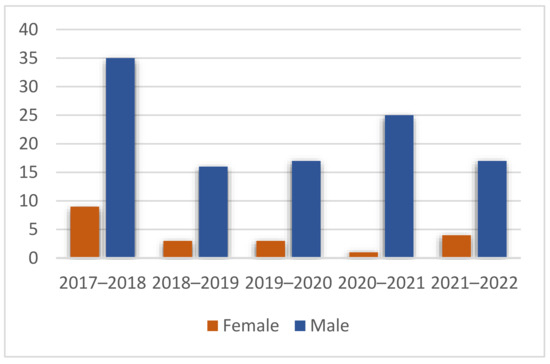
Figure 1.
Undergraduate students at the SGME, MUST.
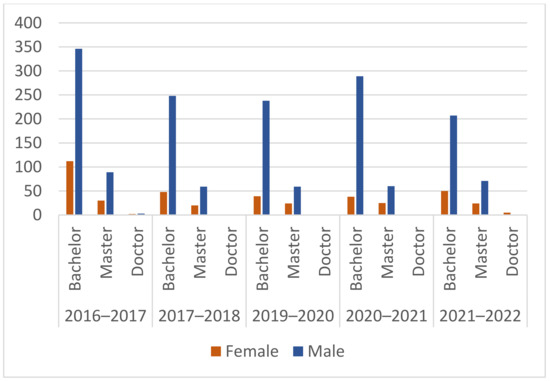
Figure 2.
Undergraduate and graduate students at SGME, MUST.
Similar trends have been observed in Australia [8], the United Kingdom and Europe [9,10,11] as well as the United States [12]. The reasons for this are likely variable and complex. While a decline in some regions may be attributed to boom–bust resource cycles (e.g., Australia), consistent trends in countries where resource-industry career opportunities are not so prevalent, suggest other causes might also be playing a role. Further, the downward trend has continued in spite of recent resource ‘boom’ times (e.g., [8]). A relative lack of exposure to geosciences in secondary schools could be a contributing factor (e.g., [9]). Likewise, the association of geosciences with industries that are increasingly perceived to be in thrall to profit-making and/or out of touch with the environmental concerns of younger generations [10] may be playing a role. (In the U.K. for example, recent drops of 9–11% (2018–2019) in annual applications to tertiary geoscience programs coincided with a 10% increase (2019) in enrolments to environmental and marine science programs [9]). Further, dissemination of scientific information to a general audience is particularly difficult for geoscientists, as they largely deal with subsurface features and esoteric processes and practices, some of which invoke dread (e.g., earthquakes, fracking, carbon capture and uranium mining to name a few) [13]. This has likely only become more challenging in the context of disinformation and mistrust of science amongst the general public [14] and may be partially responsible for a lack of understanding about the important role geoscientists will play in a sustainable future.
With regard to trends and gender ratios of students in Mongolia, we speculate that traditional attitudes regarding gender-defined roles have influenced participation in education, particularly in the fields of geoscience and mining. Girls and women are an important and valuable part of the geoscience community and universities. The geosciences encompass a broad range of fields, including geology, hydrogeology, geophysics, and environmental science, and women have made significant contributions to these fields throughout history. However, women are still underrepresented in the geosciences, particularly at higher levels of education and in leadership positions. There are several factors that contribute to this underrepresentation, including societal stereotypes about gender and science, lack of access to mentorship and networking opportunities, and bias in hiring and promotion processes.
To address this, universities can take steps to increase diversity and inclusion in their geoscience programs. This could include providing mentorship and networking opportunities for women students and faculty, implementing bias training for faculty and staff, and actively recruiting and supporting women in the geosciences. For example, to invoke positive change, MUST has put initiatives in place to promote gender equity in mining and geoscience, such as mentorship programs, scholarships, and networking events. It is also important to create a supportive and inclusive environment that welcomes and values the contributions of women in these fields. This could include promoting diversity and inclusion in hiring practices, ensuring equal pay and opportunities for career advancement, and fostering a culture of respect and inclusivity.
For educated young women in the field of geoscience, much of the challenge lies in gaining acceptance in what have traditionally been male-dominated roles. Research on gender in geoscience was conducted during the Canadian International Development Agency (CIDA) project, including the collection of statistical data on female participation in the geology sector. The results were presented at various conferences and symposiums in Mongolia, Canada, IGC, and international conferences. In Ulaanbaatar, the first “Women in Geoscience” conference was organized, co-sponsored and run by the Mongolian University of Science and Technology.
Furthermore, upper-year undergraduate and graduate students are actively working towards implementing a peer education strategy that focuses on geology, environmental protection, and mining in Mongolia for secondary school students. This initiative aims to raise awareness and educate younger generations about the importance of these subjects.
Overall, these efforts reflect the ongoing commitment to address gender disparities, promote inclusivity, and tackle environmental and safety issues within the geoscience and mining sectors in Mongolia.
3. Women in the Mongolian Mining Industry
Mining is one of the oldest industries in the world, and it has historically been predominantly male-dominated. Over the years, however, women have proven themselves to be just as capable as their male counterparts. In recent years, women have made significant progress in the industry, and there are now many initiatives in place aimed at improving gender diversity and inclusion. Women in mining face many challenges, but with the support of their colleagues and employers, they are breaking down barriers and making valuable contributions to the industry.
The mining industry has grown rapidly in the past decade, and more and more women have entered the industry. The modern-day mineral sector in Mongolia originated in 1922 with the opening of Nalaikh’s first coal mine. In 1931, of 103 employees, only three were female. Recently, women in Mongolia significantly contribute to about 1170 large and small-scale mines, but still, the number of women employees is relatively low. In 2020, mining and quarrying activities accounted for 4% of occupations at a time when the Mongolian national workforce consisted of 53% male and 47% female employees. The working-age population was 46% male and 54% female. The ILO estimates the participation rate for female workers in the mining category was 16% in 2020 (ILO Harmonized Microdata, www.ilo.org/ilostat, accessed on 20 June 2023).
While the mining sector remains male-dominated today, women work in an increasingly wide range of roles, including as board members, chief executive officers, mine managers, mine engineers, mineworkers, administrative staff, contractors and suppliers, among others. Female employees participate in most occupation roles in mining but in very low numbers. For example, female professionals account only 2% compared to 16% of males, and 2% in Plant and Machine Operators and Assemblers compared to 45% of male. On the other hand, female employees have a higher proportion of advanced-level education (47%) in mining compared to their male counterparts (37%).
4. Comparison with Other Regions
From 2012 to 2022, the average proportion of Mongolian women employed in the mining and quarrying sector was 18% compared with an overall average of 13% female participation for the rest of the Asian region, where data were available (Figure 3, Figure 4, Figure 5 and Figure 6; ILO Harmonized Microdata, www.ilo.org/ilostat, accessed on 20 June 2023). When placed in a broader, global context, female participation in the Mongolian mining and quarrying workforce is also relatively high. For example, in Oceania (Figure 7), the average proportion of women in mining and quarrying across a similar timeframe was 17% and in South America (Figure 8) it was 11%. The African region recorded a higher average female participation rate (21%) over a comparable time period than the other regions examined (Figure 9, Figure 10, Figure 11, Figure 12 and Figure 13). There is, however, significant variation in the participation rates across the subregions of the African continent. For example, 26% of the mining and quarrying workforce in Western Africa (Figure 12) was female compared with just 5% in Northern Africa (Figure 13).
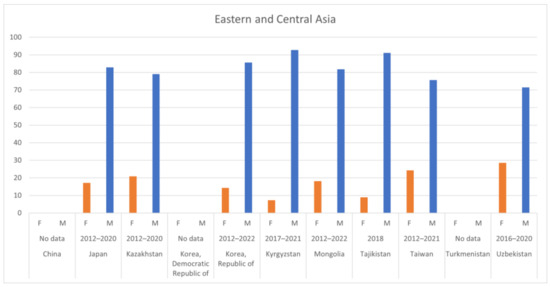
Figure 3.
Employees of the mining and quarrying sector in countries across the Eastern and Central Asian regions, coloured by gender [female (F) = orange; male (M) = blue]. NB. where the percentages for a given country do not add to 100%, this indicates there were only data for male survey participants.
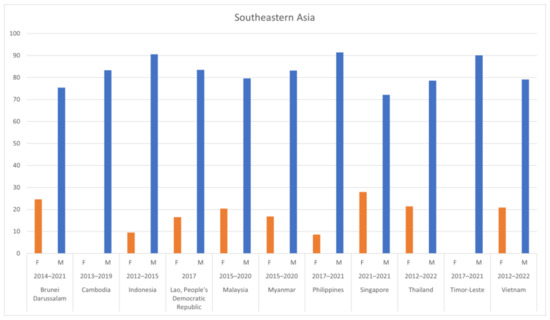
Figure 4.
Employees of the mining and quarrying sector in countries across Southeastern Asia, coloured by gender [female (F) = orange; male (M) = blue]. NB. where the percentages for a given country do not add to 100%, this indicates there were only data for male survey participants.
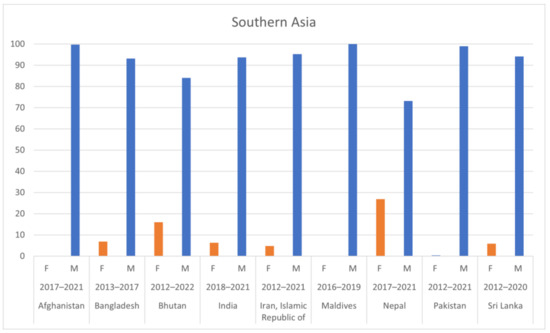
Figure 5.
Employees of the mining and quarrying sector in Southern Asian countries, coloured by gender [female (F) = orange; male (M) = blue]. NB. where the percentages for a given country do not add to 100%, this indicates there were only data for male survey participants.
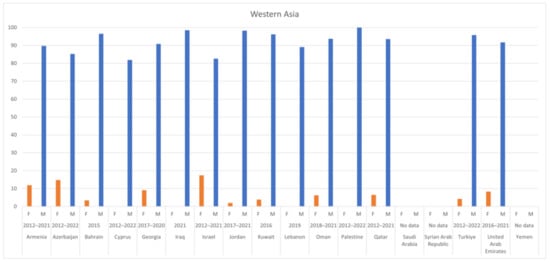
Figure 6.
Employees of the mining and quarrying sector in Western Asian countries, coloured by gender [female (F) = orange; male (M) = blue]. NB. where the percentages for a given country do not add to 100%, this indicates there were only data for male survey participants. NB. where the percentages for a given country do not add to 100%, this indicates there were only data for male survey participants.
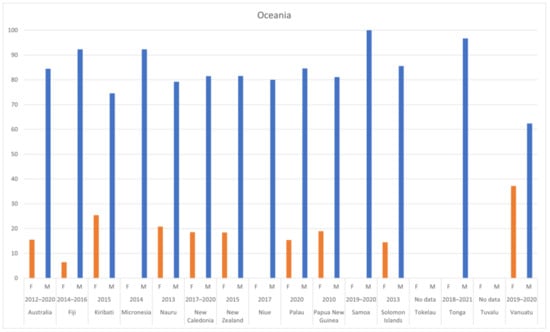
Figure 7.
Employees of the mining and quarrying sector in countries across Oceania, coloured by gender [female (F) = orange; male (M) = blue]. NB. where the percentages for a given country do not add to 100%, this indicates there were only data for male survey participants.
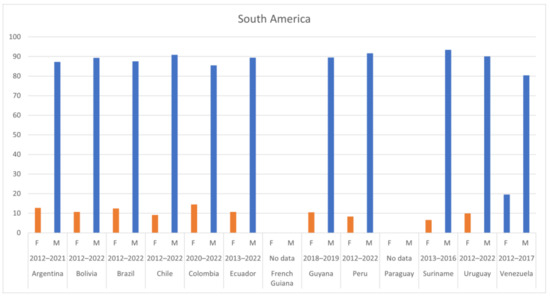
Figure 8.
Employees of the mining and quarrying sector in South American countries, coloured by gender [female (F) = orange; male (M) = blue]. NB. where the percentages for a given country do not add to 100%, this indicates there were only data for male survey participants.
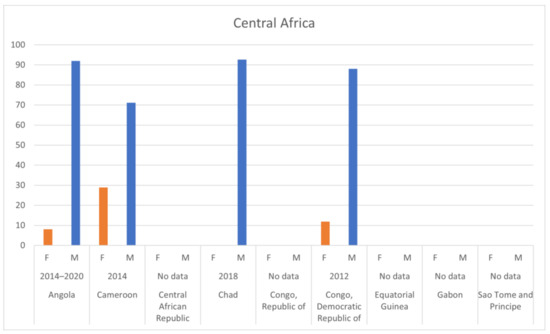
Figure 9.
Employees of the mining and quarrying sector in Central African countries, coloured by gender [female (F) = orange; male (M) = blue]. NB. where the percentages for a given country do not add to 100%, this indicates there were only data for male survey participants.
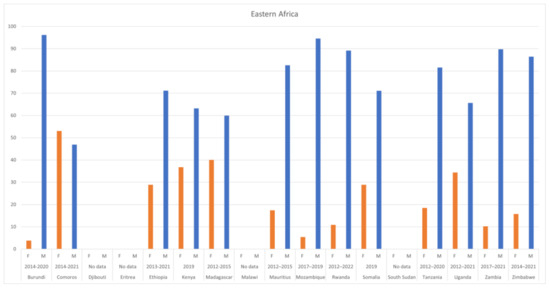
Figure 10.
Employees of the mining and quarrying sector in Eastern African countries, coloured by gender [female (F) = orange; male (M) = blue]. NB. where the percentages for a given country do not add to 100%, this indicates there were only data for male survey participants.
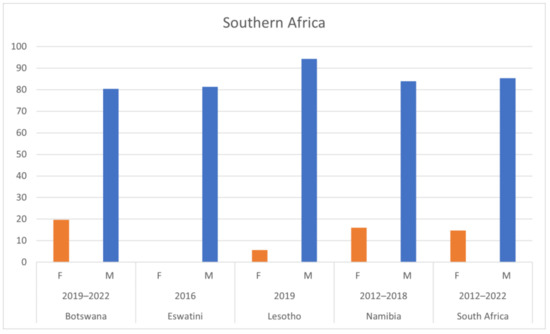
Figure 11.
Employees of the mining and quarrying sector in Southern African countries, coloured by gender [female (F) = orange; male (M) = blue]. NB. where the percentages for a given country do not add to 100%, this indicates there were only data for male survey participants.
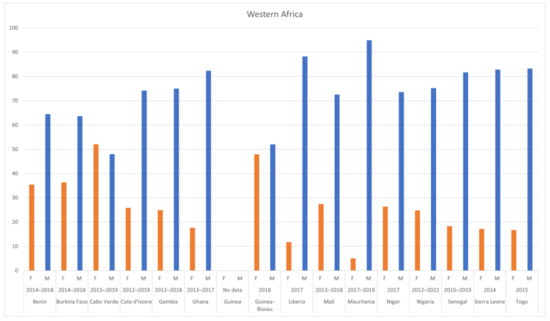
Figure 12.
Employees of the mining and quarrying sector in Western African countries, coloured by gender [female (F) = orange; male (M) = blue]. NB. where the percentages for a given country do not add to 100%, this indicates there were only data for male survey participants.
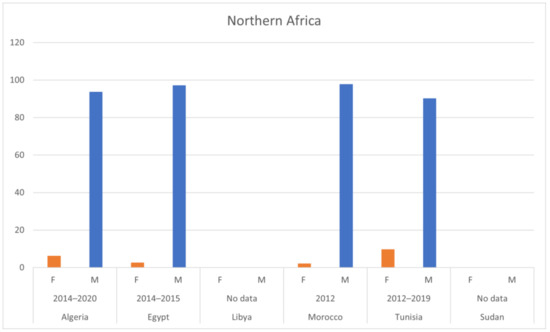
Figure 13.
Employees of the mining and quarrying sector in Northern African countries, coloured by gender [female (F) = orange; male (M) = blue]. NB. where the percentages for a given country do not add to 100%, this indicates there were only data for male survey participants.
From the broader Asia region, the countries which most resembled Mongolia’s female participation rates in the mining and quarrying sector were Israel and Japan (~17%). In Africa, gender ratios in Tanzania, Senegal, Ghana, Mauritius and Sierra Leone (17–19%) were most closely aligned. Within the Oceania region, female participation rates in the mining/quarrying industries of Papua New Guinea, New Caledonia and New Zealand, were the closest to those of Mongolia, at approximately 19%.
In Papua New Guinea, where this thematic volume was initiated, a recent World Economic Update [15] suggested that increasing female participation in the workforce (across all sectors) could result in an overall increase of 20.8% in Gross Domestic Purpose per capita over the long term. The report, which had a specific focus on gender equality, highlighted gender-based violence and discrimination as significant impediments to achieving these economic benefits as they limit access to education and employment through absenteeism and poor rates of productivity. The report advocated for changes to the Employment Act and other government interventions to reduce discriminatory practices and increase protections for women in the workforce.
5. Women at Oyu Tolgoi Mine
In Mongolia, the major producer of copper concentrate is the giant copper–gold Oyu Tolgoi deposit (31 Mt Cu, 1185 t Au, 7809 t Ag). In 2022, the Oyu Tolgoi large-scale mine employed 20,328 workers, 3577 (18%) of which, were women. In 2023, this figure has increased to 23% (https://www.ot.mn/oyu-tolgoi-releases-q1-2023-performance-results/; accessed 27 June 2023). In the open pit mine, 737 women are employed, including 66 engineers and technicians and 671 others (Figure 14). In the newly opened underground mine, the total number of women employees is 2840, including sub-contractors with 248 engineers and technicians and 2592 others. Of the Board of Directors, two are women; at management level there are 23 women, and of the senior and superintendent personnel, there are 104 women (Figure 15). Rio Tinto, the mining company that operates Oyu Tolgoi, has committed to promoting diversity and inclusion within its own workforce, including increasing the number of women in leadership positions. The company has set a target of having women make up at least 30% of its global workforce by 2030. In regard to its efforts for women in Mongolia generally, Rio Tinto has also implemented a number of initiatives aimed at supporting and empowering women in the local communities near the mine. One such initiative is the Women’s Business Empowerment Program, which provides training and resources to women entrepreneurs to help them start and grow their own businesses. The program focuses on developing skills such as financial management, marketing, and business planning.
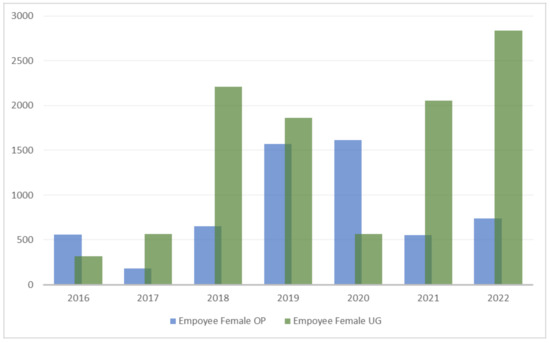
Figure 14.
Number of women employed in open pit (OP; blue) and underground (UG; green) mines at Oyu Tolgoi.
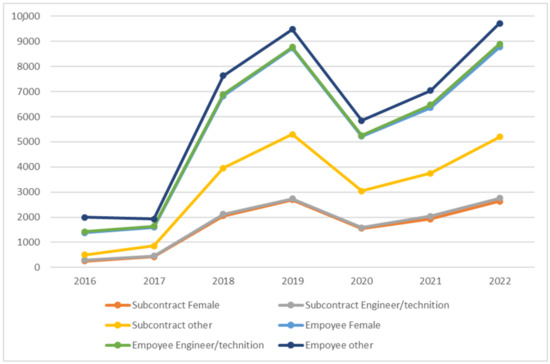
Figure 15.
Number and role of women employed in Oyu Tolgoi mine.
According to Figure 15, the number of female employees has experienced a significant increase over the past seven years, rising from 875 in 2016 to 3577 in 2022. It is noteworthy that many women are employed under contractual arrangements. The figure also illustrates the growth in female employees and subcontractors, from 253 in the past to the 2629 in 2022, with a temporary decrease observed in 2020 due to the impact of the COVID-19 pandemic. Additionally, the number of female employees in underground mines has reached 2840.
As of 31 December 2021, the corporate office of the company reported that 53% of their employees identify as female. Furthermore, 47% of the management and executive teams within the company are composed of female members. These statistics demonstrate a positive trend toward increased female representation in the workforce, particularly in leadership positions. It indicates efforts to promote gender diversity and inclusivity within the company.
Women in mining in Mongolia face many challenges, including discrimination, poor working conditions, and lack of access to training and education. However, they have made important contributions to the industry and have the potential to play an even greater role in the future. To support women in mining, there needs to be more education, investment in training and education, and an emphasis on creating safe and healthy working environments. With these steps, women in mining in Mongolia can achieve greater gender equality and help to drive the continued growth and development of the mining industry. The Mongolian government has implemented various initiatives aimed at promoting gender equality and women’s participation in the workforce, including the mining industry. For instance, the National Program on Gender Equality 2020–2024 prioritizes women’s participation in the mining sector. Many mining companies in Mongolia are recognizing the importance of gender diversity and are actively seeking to increase women’s participation in the industry. Mongolian universities and training institutions are starting to offer mining-related courses, and there are some scholarships available for women to study mining-related disciplines.
6. Professional Geoscience and Mining Women’s Organizations
Professional geoscience and mining women organizations in Mongolia play a crucial role in promoting the employment, retention, and advancement of women in the geoscience and mining industries. Recognizing the importance of gender diversity, these organizations strive to increase the representation of women in leadership positions. Women in leadership bring valuable perspectives and contribute to more well-rounded decision-making processes within organizations.
The Association of Mongolian Women Geoscientists (AMWG) was founded in 2006 with a significant strategy to promote the participation of women in geoscience, facilitate the exchange of educational, technical, and professional information, and support the professional growth and advancement of women in the geosciences. These activities have continued under the Association of Mongolian Women Geologists (AMWG), which focuses on increasing the number of women geologists in the industry, fostering a diverse approach to geoscience studies, promoting professional development among members, assisting with employment opportunities, studying gender-related concerns in Mongolia, and undertaking projects to enhance the image of women geoscientists in society.
In 2009, the AMWG published the book “Mongolian Women in Geoscience,” which provides an overview of the activities and achievements of women in various sectors, including academia, geological mapping companies, government ministries, parliament, and private small mining companies. This publication serves as a valuable resource for highlighting the significant contributions of women in the geoscience field. Indeed, the publication of additional books such as “Mongolian Women in Mining Industry” and “Geological Dynasties” by the Association of Mongolian Women Geoscientists (AMWG) further contribute to showcasing the role and achievements of women in the mining industry and the geoscience field. These publications serve as important resources for highlighting the contributions and accomplishments of women, inspiring and motivating future generations of women to pursue careers in these fields.
The challenges within the mining industry, including safety and environmental damage, are often associated with artisanal and small-scale mining (ASM) practices. The AMWG’s original project aimed to enhance the knowledge of female students and researchers regarding ASM practices, while directly addressing the environmental and safety issues associated with ASM. This demonstrates their proactive approach to addressing industry challenges and promoting sustainable and responsible mining practices.
Overall, the AMWG and its publications play a crucial role in documenting the accomplishments of women in geoscience and mining in Mongolia, promoting gender diversity and equality, and inspiring future generations of women to pursue careers in these fields. Their efforts have focused on increasing awareness of gender-related issues and developing strategies to integrate women into all aspects of geoscience research and careers, ultimately contributing to a more inclusive and equitable geoscience community in Mongolia [2].
The Women in Mining Mongolia (WIM Mongolia) organization has played a significant role in promoting gender diversity and inclusivity within the mining industry in Mongolia. Their survey findings, indicating that around 17 percent of top managers in Mongolia’s mining companies are women, highlight the progress made in terms of female representation in leadership positions.
WIM Mongolia has taken proactive steps by developing an Action Plan to further enhance diversity and inclusivity in decision-making processes within the mining sector. By actively promoting the participation of women, these organizations aim to create a more inclusive and equitable industry where different perspectives are considered in decision-making.
Women in Mining and Resources Mongolia (WMRM) is a notable not-for-profit and non-governmental organization dedicated to promoting and supporting women in the mining sector. Their focus is on providing guidance and opportunities for women in the industry.
Another active organization in Mongolia is the Women Association in Mineral Sector of Mongolia (WAMS), which has implemented several successful initiatives. These include the annual National Conference of Women in Mineral Resources, the Women Leading Responsible Mining online conference, and the development of e-learning modules on human rights and gender in the mineral resources sector. WAMS also organized the Minerals-Women national virtual forum in March 2023, which featured presentations and discussions on achievements and experiences in the mining industry by leading women experts. They also facilitated inter-sectorial discussions on topics such as “Accountable Mining”, “Women’s Leadership”, and “Good Corporate Governance–Social Impact”.
Furthermore, with the support of the MERIT project funded by the Canadian government, an association published a book titled “The Magnificent 50 or the Story That Changed Gender Stereotype”. This book showcases the stories of 50 women in various roles in the mining sector, including geologists, geophysicists, engineers, operators, and rescuers. It serves as an inspiring compilation highlighting the contributions and achievements of women in the mining industry.
These organizations and initiatives play a crucial role in promoting gender equality, empowering women in the mining sector, and challenging gender stereotypes. They provide platforms for knowledge sharing, networking, and advocating for the advancement of women’s careers and leadership in the industry.
The growth of the mining industry in Mongolia underscores the importance of women’s active involvement for its continued success. Without the understanding, education, and participation of women in the sector, the industry may face challenges in terms of achieving sustainable development and addressing various concerns.
The efforts of professional geoscience and mining women organizations, such as WIM Mongolia, are crucial in empowering and supporting women in these fields. Their work contributes to the overall development and sustainability of the mining industry in Mongolia by fostering a more diverse and inclusive environment.
The Association of Mongolian Women Engineers, Technologists, Scientists and Mathematicians (Mongolian WSTEM) was established in 2011 to support the activities of Mongolian women scientists, and to make a significant contribution to the country’s development in engineering, technology, and the sciences. From its beginning, Mongolian WSTEM was a member organization of the International Network of Women Engineers and Scientists (INWES), a non-profit organization that is active internationally through its regional branches in more than 60 countries. These organizations provide networking opportunities, mentorship, and support for women in these fields, often through virtual meetings exchanging information on accountable mining, sustainable development and gender issues.
Further afield, in the Australasian region (including Australia, New Zealand, Melanesia, and the western Pacific Ocean islands of Polynesia), there is a concurrent effort underway by similar women-focused networks to better understand the status of gender equity in geosciences [16]. Unsurprisingly, the contributing factors for gender inequality that have been identified are in common with those identified in Mongolia. Systemic, social and, in some cases, legislative issues have all been highlighted as significant barriers to gender equity across this region (e.g., see also [15]), and a number of remedial strategies have been suggested. In particular, moves to improve the visibility of women geoscientists (e.g., public databases of women scientists), efforts to eliminate sexual harassment and assault in education and the workplace, and regular collection and analysis of statistical data that monitors progress [16]. It is noted that these strategies must be targeted consistently towards all levels of education and career development and championed by members of the wider geoscientific community in order to be successful in creating positive change.
7. Future of Women in Geoscience and Mining
Mongolia has a rich geological history and possesses a diverse range of mineral resources, making geoscience education a critical component of the country’s educational system. Improving geoscience education in Mongolia requires a multi-faceted approach that addresses the funding, curriculum, and career development aspects of the field. By investing in geoscience education, Mongolia can build a strong foundation for sustainable development and resource management in the future.
It is important to encourage more girl students to pursue careers in geoscience and mining. This could be achieved through targeted outreach programs, scholarships and internships, and by highlighting the diverse career opportunities available in the field of geology and mining.
Indeed, Mongolia’s female-to-male gender ratios across the mining industry are similar to, or better than, many other regions globally (Section 4). However, there are several challenges that need to be addressed to advance gender equality in both the mining industry and geoscience education in Mongolia. Eliminating gender discrimination and improving working conditions as well as access to training and education will be crucial and, as in the case of other countries, would likely result in significantly increased national economic benefits (e.g., [15]).
The future for women in geoscience and mining in Mongolia is a complex and dynamic issue that is influenced by various factors such as social and cultural norms, government policies, and economic trends. Moreover, considering the challenges faced by the mining industry, such as safety concerns and environmental impact, it becomes evident that addressing these issues requires the active participation and understanding of women. Their knowledge, education, and perspectives are crucial to ensuring sustainable practices and positive social impact within the industry.
By acknowledging the importance of gender dynamics, promoting inclusivity, and supporting the professional growth of women in geoscience and mining, Mongolia can foster a more equitable and diverse industry. This, in turn, will contribute to the overall development and sustainability of the geoscience and mining sectors in the country.
Author Contributions
G.O. developed the idea and wrote the manuscript. M.B., M.S. and H.W. collected data and wrote a part of the manuscript. All authors have read and agreed to the published version of the manuscript.
Funding
We thank the Auckland University of Technology (AUT) for providing the publication fees for this article.
Data Availability Statement
The authors declare that all statistical data supporting this study are available within the paper or cited in references.
Acknowledgments
The authors are very grateful to two anonymous reviewers and Mike Petterson for their constructive feedback, which has considerably improved the manuscript.
Conflicts of Interest
The authors declare no conflict of interest.
References
- Cane, I. Social and Gendered Impacts Related to Mining, Mongolia. Prepared by: Adam Smith International. 2015. Available online: https://www.dfat.gov.au/sites/default/files/mongolia-social-gendered-impacts-related-to-mining.pdf (accessed on 27 June 2023).
- Gerel, O.; Batkhishig, B.; Myagmarsuren, S. Mongolian Women in geosciences: The appearance and reality of changing gender roles. Atl. Geol. 2006, 42, 85–86. [Google Scholar]
- Gerel, O.; Munkhtsengel, B. (Eds.) Mongolian Women in Geoscience; Monkhiin Useg Group: Ulaanbaatar, Mongolia; 293p. (In Mongolian)
- Gerel, O. Geology and Metallogeny of Mongolia. In Mineral Resources of Mongolia; Springer: Singapore, 2021; pp. 1–21. [Google Scholar] [CrossRef]
- Women and the Mine of the Future. International Labour Organization. Available online: https://www.ilo.org/wcmsp5/groups/public/---ed_dialogue/---sector/documents/publication/wcms_839705.pdf (accessed on 27 June 2023).
- Errami, E.; Gerel, O.; Peppoloni, S. Geosciences and the Sustainable Development Goals. In Achieve Gender Equality and Empower All Women and Girls; Springer: Cham, Switzerland, 2021; pp. 105–127. [Google Scholar] [CrossRef]
- Ankhbayar, B. Development of an Index of Evaluation of Gender Equality in Higher Education Institutions: On the Example of Mongolian University of Science and Technology. Ph.D. Thesis, MUST Press, Ulaanbaatar, Mongolia, 2022; 110p. [Google Scholar]
- Cohen, D.R. Australian Geoscience Tertiary Education Profile 2003–2021. Report to the Australian Geoscience Council. 2022. Available online: https://www.agc.org.au/resources/reports/australian-geoscience-council-report/ (accessed on 27 June 2023).
- Boatright, D.; Davies-Vollum, S.; King, C. Earth Science Education: The current state at play. In Geologist; Whitchurch, A., Ed.; Geological Society of London: London, UK, 2019; pp. 16–19. [Google Scholar]
- Storey, C.; Darling, J.; Koor, N. Geologists get called ‘dirty polluters’, but we’re needed to fight climate change. Conversation. 2019. Available online: https://theconversation.com/geologists-get-called-dirty-polluters-but-were-needed-to-fight-climate-change-121965 (accessed on 27 June 2023).
- Jermyn, C.; Corcimaru, V.; de Mulder, E. Earth Science Education at a Crossroad—Headed Toward an Irreversible Decline or Paving the Way to a Sustainable Future? J. Geol. Soc. India 2023, 99, 151–155. [Google Scholar] [CrossRef]
- Keane, C. U.S. Geoscience Enrollments and Degrees Collapse in 2019–2020. AGI Geoscience Currents. Available online: https://www.americangeosciences.org/geoscience-currents/ (accessed on 1 August 2023).
- Stewart, I.S.; Lewis, D. Communicating contested geoscience to the public: Moving from ‘matters of fact’ to ‘matters of concern’. Earth Sci. Rev. 2017, 174, 122–133. [Google Scholar] [CrossRef]
- Ecker, U.K.H.; Lewandowsky, S.; Cook, J.; Schmid, P.; Fazio, L.K.; Brashier, N.; Kendeou, P.; Vraga, E.K.; Amazeen, M.A. The psychological drivers of misinformation belief and its resistance to correction. Nat. Rev. Psychol. 2023, 1, 13–29. [Google Scholar] [CrossRef]
- The World Bank. Papua New Guinea Economic Update, March 2023: Unlocking the Economic Benefits of Gender Equality; World Bank Group: Washington, DC, USA, 2023. [Google Scholar] [CrossRef]
- Handley, H.K.; Hillman, J.; Finch, M.; Ubide, T.; Kachovich, S.; McLaren, S.; Petts, A.; Purandare, J.; Foote, A.; Tiddy, C. In Australasia, gender is still on the agenda in geosciences. Adv. Geosci. 2020, 53, 205–226. [Google Scholar] [CrossRef]
Disclaimer/Publisher’s Note: The statements, opinions and data contained in all publications are solely those of the individual author(s) and contributor(s) and not of MDPI and/or the editor(s). MDPI and/or the editor(s) disclaim responsibility for any injury to people or property resulting from any ideas, methods, instructions or products referred to in the content. |
© 2023 by the authors. Licensee MDPI, Basel, Switzerland. This article is an open access article distributed under the terms and conditions of the Creative Commons Attribution (CC BY) license (https://creativecommons.org/licenses/by/4.0/).